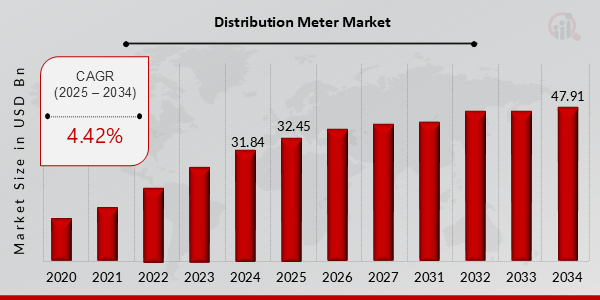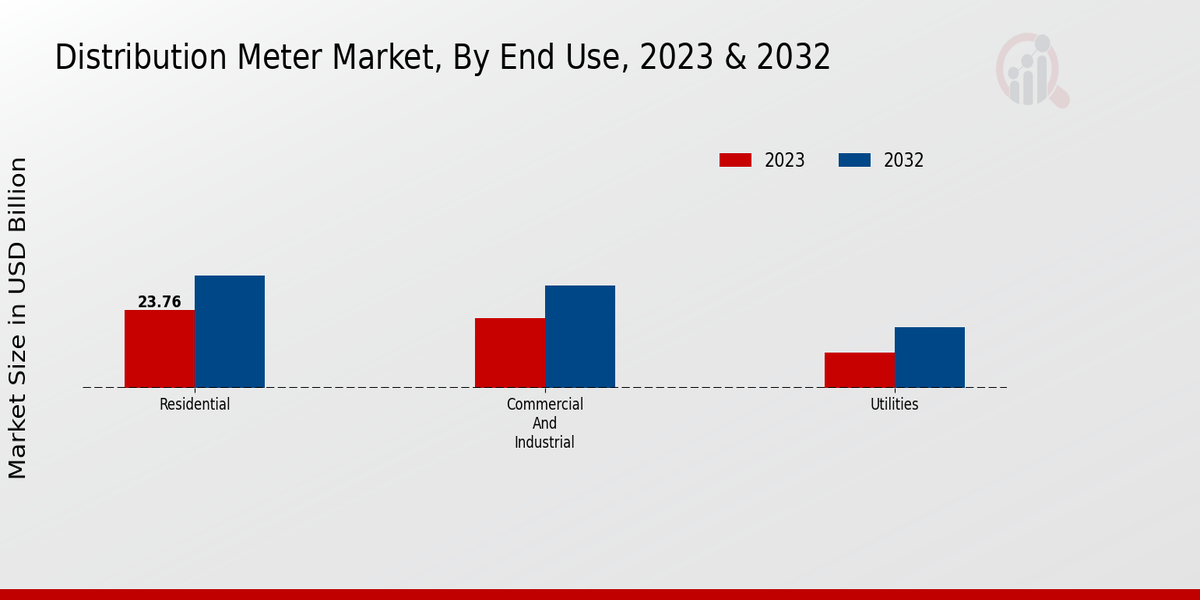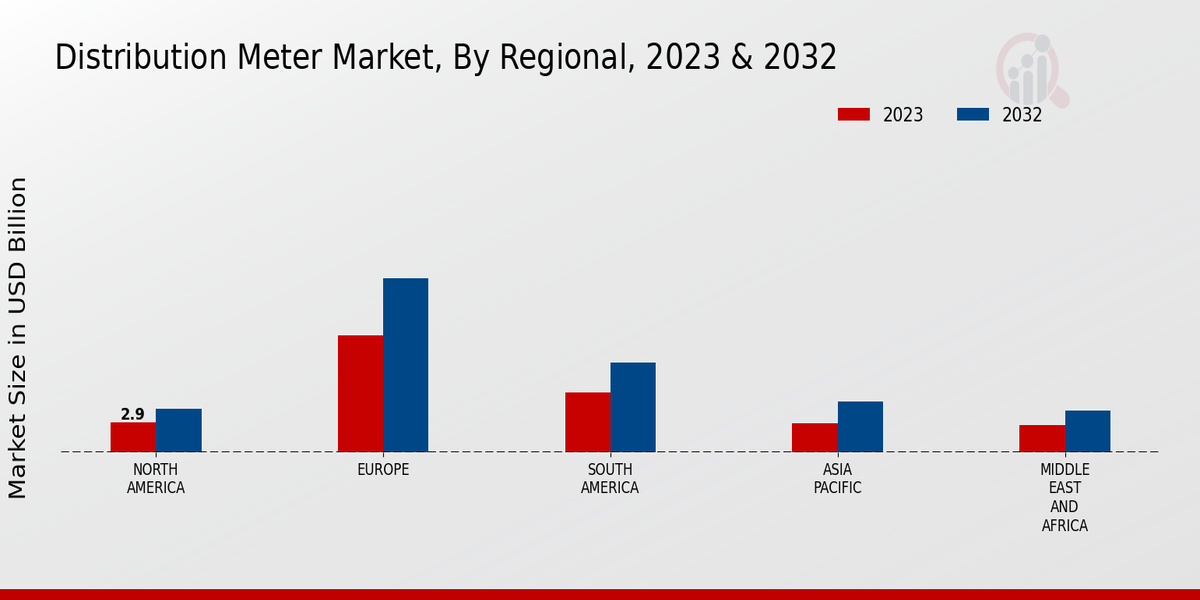Global Distribution Meter Market Overview
Distribution Meter Market Size was estimated at 31.84 (USD Billion) in 2024. The Distribution Meter Market Industry is expected to grow from 32.45 (USD Billion) in 2025 to 47.91 (USD Billion) till 2034, exhibiting a compound annual growth rate (CAGR) of 4.42% during the forecast period (2025 - 2034).
Key Distribution Meter Market Trends Highlighted
Key market drivers for Distribution Meter Market include rising demand for accurate and efficient metering solutions, increasing investments in smart grid infrastructure, and growing emphasis on energy conservation.
Opportunities to be explored and captured lie in the integration of advanced technologies such as IoT and AI, providing real-time monitoring and analytics capabilities. Additionally, the growing adoption of renewable energy sources and the need for grid modernization present significant opportunities for the distribution meter market.
Recent trends in the distribution meter market include a shift towards smart meters, with advanced features such as remote monitoring, data communication, and demand-response capabilities. Focus is also being placed on improving accuracy, reliability, and durability of distribution meters to meet industry standards and enhance customer satisfaction.

Source: Primary Research, Secondary Research, MRFR Database and Analyst Review
Distribution Meter Market Drivers
Rising Demand for Smart Grid Infrastructure
The increasing adoption of
smart grid technologies is a major driver for the growth of the Distribution Meter Market Industry. Smart grids enable real-time monitoring and control of electricity distribution networks, which helps utilities to improve efficiency, reduce costs, and enhance reliability. Distribution meters are essential components of smart grids, as they provide accurate and timely data on electricity consumption and power quality. The rising demand for smart grid infrastructure is therefore expected to drive the growth of the Distribution Meter Market Industry in the coming years. Smart grids offer several benefits over traditional electricity distribution networks. They can help to reduce energy consumption and greenhouse gas emissions by optimizing the flow of electricity and identifying areas of waste. Smart grids can also improve reliability and resilience by automatically detecting and responding to outages. As a result, governments and utilities around the world are investing heavily in the development of smart grid infrastructure. The growth of the smart grid market is expected to drive demand for distribution meters. Distribution meters are essential components of smart grids, as they provide the data needed to monitor and control the distribution network. As smart grid deployments increase, the demand for distribution meters is also expected to grow. In addition, the increasing adoption of renewable energy sources is also driving the demand for distribution meters. Renewable energy sources, such as solar and wind power, are intermittent and variable. This can make it difficult to manage the electricity grid and ensure a reliable supply of power. Distribution meters can help to integrate renewable energy sources into the grid by providing real-time data on electricity generation and consumption. The increasing demand for smart grid infrastructure, the growing adoption of renewable energy sources, and the need for improved energy efficiency are all factors that are expected to drive the growth of the Distribution Meter Market Industry in the coming years.
Government Regulations and Incentives
Government regulations and incentives are another important driver for the growth of the Distribution Meter Market Industry. Governments around the world are increasingly implementing regulations that require utilities to install advanced metering infrastructure (AMI). AMI systems include distribution meters, which provide utilities with real-time data on electricity consumption and power quality. Government incentives are also playing a role in driving the adoption of distribution meters. Many governments are offering financial incentives to utilities that install AMI systems. These incentives can help to reduce the cost of AMI deployments and make them more affordable for utilities. The increasing adoption of AMI systems is expected to drive the growth of the Distribution Meter Market Industry in the coming years. AMI systems provide utilities with a number of benefits, including improved customer service, reduced operating costs, and enhanced grid reliability. As a result, governments and utilities are increasingly investing in AMI deployments. The growth of the AMI market is expected to drive demand for distribution meters. Distribution meters are essential components of AMI systems, as they provide the data needed to monitor and control the distribution network. As AMI deployments increase, the demand for distribution meters is also expected to grow.
Technological Advancements
Technological advancements are also driving the growth of the Distribution Meter Market Industry. Distribution meters are becoming increasingly sophisticated and accurate. New technologies are also making it possible to integrate distribution meters with other smart grid devices and systems. The increasing sophistication of distribution meters is providing utilities with more data and insights into their distribution networks. This data can be used to improve grid management, reduce costs, and enhance reliability. The integration of distribution meters with other smart grid devices and systems is also enabling new applications and services. For example, distribution meters can be integrated with demand response programs. Demand response programs allow utilities to reduce peak demand by offering customers financial incentives to reduce their electricity consumption during peak hours. Distribution meters can also be integrated with renewable energy systems. This integration allows utilities to track the generation and consumption of renewable energy, and to optimize the use of renewable energy resources. Technological advancements are expected to continue to drive the growth of the Distribution Meter Market Industry in the coming years. New technologies are making distribution meters more sophisticated, accurate, and versatile. These advancements are also enabling new applications and services that can help utilities to improve grid management, reduce costs, and enhance reliability.
Distribution Meter Market Segment Insights:
Distribution Meter Market End Use Insights
End Use The Distribution Meter Market segmentation by end use comprises residential, commercial and industrial, and utilities. Among these segments, the residential segment held the largest market share in 2023 and is anticipated to maintain its dominance throughout the forecast period. The increasing adoption of
smart homes and the rising demand for energy-efficient appliances are the key factors driving the growth of the residential segment. The commercial and industrial segment is expected to witness substantial growth during the forecast period due to the growing demand for distribution meters in various industries, such as manufacturing, healthcare, and transportation. The utilities segment is also poised for significant growth, driven by the increasing need for accurate metering and monitoring of electricity consumption. In 2023, the residential segment accounted for approximately 40% of the Distribution Meter Market revenue, while the commercial and industrial segment held a share of around 35%. The utilities segment contributed the remaining 25% to the market revenue. The growth of the Distribution Meter Market is primarily attributed to the increasing demand for smart meters, which offer advanced features such as remote monitoring, real-time data collection, and automated billing. Furthermore, government regulations and incentives aimed at promoting energy conservation and reducing carbon emissions are also contributing to the market growth.

Source: Primary Research, Secondary Research, MRFR Database and Analyst Review
Distribution Meter Market Meter Type Insights
The Distribution Meter Market is segmented by Meter Type into Electromechanical Meters, Electronic Meters, and Smart Meters. Among these, the Smart Meters segment holds the largest market share due to the increasing adoption of smart grid technologies and the growing need for real-time energy monitoring and control. Smart Meters offer advanced features such as
remote monitoring, automated billing, and demand-side management capabilities, which make them a preferred choice for utilities and consumers. The Electronic Meters segment is also expected to witness significant growth due to their accuracy, reliability, and cost-effectiveness compared to electromechanical meters. Electromechanical Meters, on the other hand, are expected to have a gradual decline in market share as they are being replaced by more advanced electronic and smart meters.
Distribution Meter Market Voltage Insights
The Distribution Meter Market is segmented by voltage into low voltage (less than 1 kV), medium voltage (1 kV to 33 kV), and high voltage (above 33 kV). The low voltage segment is expected to account for the largest share of the market in 2023, due to the increasing adoption of smart meters in residential and commercial buildings. The medium voltage segment is also expected to grow significantly, due to the rising demand for electricity from industrial and commercial sectors. The high voltage segment is expected to have the smallest share of the market, but is expected to grow at the fastest rate, due to the increasing demand for electricity from renewable energy sources.
Distribution Meter Market Communication Technology Insights
The communication technology segment plays a crucial role in the distribution meter market, enabling efficient data transmission and communication between distribution meters and utilities. Wired communication, primarily using Ethernet or power line communication (PLC), provides a reliable and secure connection, ensuring real-time data transfer for billing, monitoring, and control purposes. Wireless communication, employing technologies like Wi-Fi, Zigbee, and cellular networks, offers increased flexibility and cost-effectiveness, making it suitable for remote areas or challenging environments.Cellular communication, particularly leveraging 4G and 5G networks, enables advanced capabilities such as remote firmware updates, demand response programs, and smart grid integration. The Distribution Meter Market revenue for communication technology is projected to reach USD 10.2 billion by 2024, exhibiting a steady growth rate. This growth is driven by the increasing adoption of smart meters, the need for enhanced grid efficiency, and the proliferation of IoT devices in the energy sector. Key market players are investing in research and development to improve communication technologies, focusing on enhancing data security, reliability, and interoperability.
Distribution Meter Market Regional Insights
The regional segmentation of the Distribution Meter Market offers insights into the market's performance across different geographical regions. Among these regions, North America and Europe hold significant market shares due to the presence of established electrical infrastructure and high demand for advanced metering solutions. The APAC region is anticipated to witness substantial growth in the coming years, driven by increasing urbanization and government initiatives to modernize grid infrastructure. South America and MEA also present growth opportunities due to increasing investments in the power sector and a growing focus on energy efficiency.Overall, the Distribution Meter Market is expected to exhibit promising growth prospects in all regions, contributing to the overall market expansion.

Source: Primary Research, Secondary Research, MRFR Database and Analyst Review
Distribution Meter Market Key Players And Competitive Insights:
Major players in Distribution Meter Market industry are constantly striving to gain a competitive edge by introducing innovative products and technologies. Leading Distribution Meter Market players are focusing on developing advanced metering infrastructure (AMI) solutions, including smart meters and communication networks, to improve grid efficiency and customer engagement. The Distribution Meter Market development efforts are driven by the growing demand for real-time data and analytics to optimize energy consumption and reduce operational costs. Strategic partnerships and collaborations are becoming increasingly common in the Distribution Meter Market Competitive Landscape, as companies seek to combine their strengths and expand their market reach.ABB, a global leader in power and automation technologies, holds a significant position in the Distribution Meter Market. The company offers a comprehensive portfolio of distribution meters, including smart meters, current transformers, and voltage transformers. ABB's focus on research and development has resulted in innovative metering solutions such as the Ekip UP smart meter, which provides advanced features like remote monitoring, load profiling, and power quality analysis. With a strong global presence and a commitment to customer service, ABB continues to be a formidable player in the Distribution Meter Market.Schneider Electric, another industry leader, offers a wide range of distribution meters under its PowerLogic brand. The company's focus on sustainability and energy efficiency is reflected in its metering solutions, which help customers optimize their energy usage and reduce their carbon footprint. Schneider Electric's acquisition of Itron, a leading provider of smart metering solutions, has further strengthened its position in the Distribution Meter Market. The company's commitment to innovation and customer satisfaction has made it a trusted partner for utilities and industrial customers worldwide.
Key Companies in the Distribution Meter Market Include:
- Maxim Integrated Products, Inc.
- Analog Devices
- Microchip Technology Inc.
- Itron, Inc.
- Secure Metering Systems
- Renesas Electronics Corporation
- Elster Group
- ABB Group
- Landis+Gyr
- Yokogawa Electric Corporation
- ON Semiconductor
- Texas Instruments
- Schneider Electric
- General Electric
- Honeywell International Inc.
Distribution Meter Industry Developments
The Distribution Meter Market continues to experience growth due to increasing demand for accurate and efficient metering solutions. Smart grid infrastructure investments, government regulations promoting energy conservation, and rising awareness about smart metering technologies are driving market expansion. The market is expected to witness significant growth in the coming years, with a focus on advanced metering infrastructure (AMI) solutions and real-time monitoring capabilities. Key players in the market are investing in research and development to enhance their product offerings and gain a competitive edge. Strategic partnerships and collaborations are also shaping the market landscape, as companies seek to expand their reach and offer integrated solutions.
Distribution Meter Market Segmentation Insights
Distribution Meter Market End Use Outlook
- Residential
- Commercial and Industrial
- Utilities
Distribution Meter Market Meter Type Outlook
- Electromechanical Meters
- Electronic Meters
- Smart Meters
Distribution Meter Market Voltage Outlook
- Low Voltage (less than 1 kV)
- Medium Voltage (1 kV to 33 kV)
- High Voltage (above 33 kV)
Distribution Meter Market Communication Technology Outlook
Distribution Meter Market Regional Outlook
- North America
- Europe
- South America
- Asia Pacific
- Middle East and Africa
|
Report Attribute/Metric
|
Details
|
|
Market Size 2024
|
USD 31.84 Billion
|
|
Market Size 2025
|
USD 32.45 Billion
|
|
Market Size 2034
|
USD 47.91 Billion
|
|
Compound Annual Growth Rate (CAGR)
|
4.42% (2025-2034)
|
|
Base Year
|
2024
|
|
Market Forecast Period
|
2025-2034
|
|
Historical Data
|
2020-2023
|
| Market Forecast Units |
USD Billion |
| Key Companies Profiled |
Maxim Integrated Products, Inc., Analog Devices, Microchip Technology Inc., Itron, Inc., Secure Metering Systems, Renesas Electronics Corporation, Elster Group, ABB Group, Landis+Gyr, Yokogawa Electric Corporation, ON Semiconductor, Texas Instruments, Schneider Electric, General Electric, Honeywell International Inc. |
| Segments Covered |
End Use, Meter Type, Voltage, Communication Technology, Regional |
| Key Market Opportunities |
Smart grid modernization Increasing demand for renewable energy Growing focus on energy efficiency Advancement in metering technologies Government incentives for grid infrastructure upgrades |
| Key Market Dynamics |
Growing demand Technological advancements Smart grid integration Rising adoption of smart homes Government initiatives |
| Countries Covered |
North America, Europe, APAC, South America, MEA |
Frequently Asked Questions (FAQ) :
The Distribution Meter Market is expected to reach USD 47.91 billion by 2034, exhibiting a CAGR of 4.42% from 2025 to 2034.
Asia-Pacific is anticipated to dominate the market, accounting for the largest share of revenue.
Distribution meters are primarily used in electricity distribution networks for measuring and monitoring electricity consumption.
Prominent players in the market include Itron, Inc., Landis+Gyr, Schneider Electric, Siemens AG, and General Electric.
The market is projected to expand at a CAGR of 4.42% during the forecast period.
Rising demand for electricity, increasing adoption of smart grid technologies, and government initiatives to promote energy efficiency are driving market growth.
Challenges include the high cost of implementation, lack of standardization, and cybersecurity concerns.
Trends include the adoption of wireless communication technologies, integration with renewable energy sources, and the development of advanced metering infrastructure (AMI).
Digitalization is transforming the market by enabling remote monitoring, data analytics, and improved grid management.
Growth opportunities lie in the expansion of smart cities, the deployment of AMI systems, and the increasing focus on energy conservation.

















